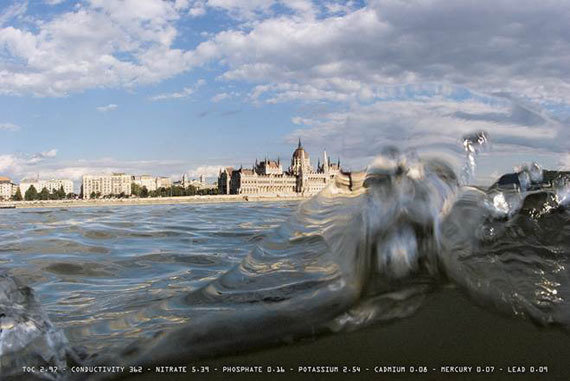Andreas Muller-Pohle
dal 20/7/2014 al 27/9/2014
Segnalato da
20/7/2014
Andreas Muller-Pohle
City Gallery Prague, Prague
Coincidences. The exhibition consists of 17 series and projects: from his influential early "visualistic" series of photographs to multimedia works dealing with the transition between analogue and digital codes and the newest long-term projects depicting current civilization in a global perspective.

A Select Retrospective
curated by Pavel Vancat
The Berlin‑based artist Andreas Müller‑Pohle is one of the key figures engaged in the ontological as well as representational essence of photography since the mid 1970s. Since the 1990s, he has reflected on the radical changes in the essence of technical images. The constantly reoccurring question of the encoding and meaning of information and its dialectical opposition to entropy and chance point to the mutual influence of Müller‑Pohle’s work and the thinking of the Czech‑born media philosopher Vilém Flusser. The artist’s “select retrospective” in Prague consists of 17 series and projects: from his influential early “visualistic” series of photographs to multi‑media works dealing with the transition between analogue and digital codes and the newest long‑term projects depicting current civilization in a global perspective.
VISUALISM AND ENTROPY
While the author’s first photographic series, “Constellations” (1976—1979), distilled the principles of avant‑garde photography down to primary forms, the series that followed, “Transformance” (1979—1982), is a kind of ironic de‑construction of a “photographic gesture”, foreshadowing the subsequent “quantum” arrangements of his further projects.
The artist’s theoretical and publishing activities also had fundamental importance for European photography. In 1979, Müller‑Pohle founded the still influential magazine European Photography, in which he published, one year later, his manifest of visualism, where he convincingly described, based on existing history, the position of many other authors at the end of modernity (in the Czech environment, for example, Štěpán Grygar, Miroslav Machotka or Marie Kratochvílová were freely inspired by him). In 1981, Müller‑Pohle met the media philosopher Vilém Flusser at a symposium in Düsseldorf, which initiated a decade of very close and prolific cooperation. In 1983, European Photography published Flusser’s fundamental essay “Für eine Philosophie der Fotografie” (Towards a Philosophy of Photography) in the form of a book, which soon became one of the key texts on the theory of photography in the 20th century.
Müller‑Pohle’s subsequent series (“Albufera”, “Dacapo”, “Signa” and the “Cyclograms”) further examine and undermine the integrity of the photographic image as an independent visual symbol, as well as the relations of its further use. In his project “Entropia” (1996), the artist reacted to the omnipresence of images with a radical gesture: He had eleven thousand photographs, lithographic films, framed pictures and other photographic “waste” scrapped by a huge industrial shredder. This act served as the final outcome of Müller‑Pohle’s “iconoclastic” phase. The final video shows the process of the extinction of images, oscillating between ecology and the black hole. A later outcome of this project also includes two isolated “photo‑sculptures”: Photo Box and a set of Entropic Cylinders, made from the subsequent “entropic” garbage that perfectly illustrated the gradual extinction of analogue information.
CODES AND HISTORY
Since the mid 1990s, Müller‑Pohle also pursued the then gradually incoming digitalisation of images, beginning with the series “Digital Scores (after Nicéphore Niépce)”, for which he digitalised Niépce’s photograph “La cour du domaine du Gras” (View from a Window in Le Gras), 1826, into alphanumeric code. It seems here that a natural step after the apocalyptic Entropy would be to turn to the upcoming digitalization, which came to establish a new order of things. In the following years, Müller‑Pohle became one of the first artists to work with the decomposition and translation of analogue and digital image codes (“Face Codes”, “Blind Genes” and “Sojourner II”).
In several projects, Müller‑Pohle transformed the subject of coding (or even codification) on a politically historical level: In a film record of a radio speech announcing the bombing of Hiroshima, we see President Harry S. Truman joking; in contrast, the memory of Hiroshima is transformed by a “historic” record created by an antique film camera, underpinned by a contemporary audio walk around the “A‑Bomb Dome”, Hiroshima’s well‑known landmark.
GLOBAL SYSTEMS
A completely new phase of Müller‑Pohle’s work begins with the extensive “Danube River Project” (2005—2006), which documents the entire stream of this great European river from photographic, ecological and cultural perspectives.
The project “Hong Kong Waters” (2009—2010) freely follows up on the above, as well as on the “Transformance” series, since it makes use of accidental exposures from a camera floating on water; this time, however, the result is an extensive photographic and video document of the constantly growing megalopolis from the water surface view. The artist’s most recent project has global dimensions: In the as yet incomplete series titled “Studies on Traffic”, he examines the patterns of movement in various parts of the world (especially in Asia, to which he has a special connection). The commotion of motorcycles in Vietnam, the rhythm of a busy street in Hong Kong interrupted by a sudden grotesque accident, or an endless traffic jam, all portray our current civilization as a seemingly indescribable Brownian motion consisting of billions of subjective entities.
As a whole, Andreas Müller‑Pohle’s oeuvre follows a well thought‑out and logical path from classic photography to complicated system phenomena, and demonstrates that he is a unique artist, linking theoretical and artistic thought across four decades. With a complexity that captivates and questions at the same time, Müller‑Pohle’s work reveals more about the world in the past several decades than we are perhaps willing to admit.
— Pavel Vančát
Image: Budapest. From The Danube River Project, 2005
Andreas Müller-Pohle will discuss his work with Siegfried Zielinski and Gottfried Baruch in the auditorium of the Goethe Institut Prague on Tuesday 22 July at 6:00 pm.
Press contact:
Kristýna Kočová tel.: 725 818 721, e-mail: Kristyna.Kocova@ghmp.cz
Alice Lenská tel.: 224 826 391, 725 811 936, e-mail: Alice.Lenska@ghmp.cz
Opening on Monday, 21 July 6:00 pm
Prague City Gallery House of Photography
Revoluční 5, 110 00 Prague 1 Czech Republic
Hours: Tue-Sun 10am-6pm



